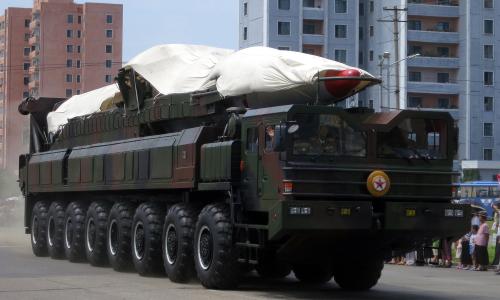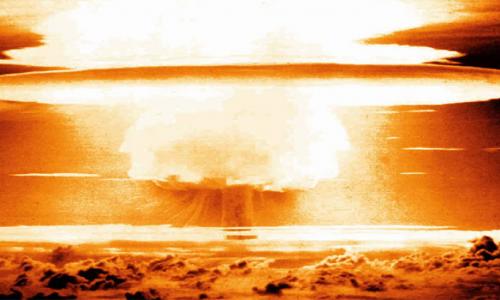Today, North Korea is estimated to have enough fissile materials for over 50 nuclear warheads. It also continues to develop its long-range missile capabilities, though its capabilities remain unclear.
It continues to advance its nuclear arsenal quantitatively and qualitatively, while its leader Kim Jong Un calls for “greater warfighting capabilities” against the United States and South Korea, identifies Seoul as a "constitution" to abandon the goal of peaceful reunification with the South.
In 2022 alone, North Korea conducted ~70 missile tests, setting a record since its first missile launch in 1984. The missile tests continued through 2023 when North Korea also resumed its space launch program. It claimed to have successfully launched a reconnaissance satellite and pledged to launch three more in 2024. North Korea is also pursuing enhanced strategic cooperation with Russia, supplying Russia with containers of conventional weapons, while Russia reciprocates with food, fuel, and weapons technology that can further accelerate North Korea’s nuclear programs.
The changing rhetoric and policies, coupled with the ongoing expansion of its nuclear weapons program and lack of interest in diplomacy, have led some experts to believe that North Korea has made a strategic decision to go to war. North Korea’s military developments make it increasingly able to threaten its neighbors and more distant countries.

Sanctions, military actions, or diplomacy?
Discussions between the United States and its allies on how to reduce the threat of North Korea’s weapons typically include three options: sanctions, military action, and diplomacy.
Sanctions can help reduce North Korea’s ability to buy foreign technology that might be useful for weapons and can pressure the Pyongyang government in other ways. While sanctions contributed to decelerating the pace of its weapons program, North Korea often finds ways to circumvent sanctions, and sanctions alone are unlikely to stop the country’s military programs.
Military options are highly uncertain to be successful and would almost certainly lead North Korea to attack South Korea or other targets with conventional or possibly chemical or nuclear weapons. The potential loss of civilian life would be unacceptable. As a result, US military officials and other security experts—including the Union of Concerned Scientists—argue that there are no good military options to reduce the threat of North Korea’s nuclear weapons.
Diplomacy—including open lines of communication and formal and informal talks—has been the most optimal option to date. Diplomacy acts to alleviate tensions and hostility and lays the groundwork for a longer process to reduce the threat from North Korea
Some diplomacy with North Korea has been successful in the past. A 1994 agreement averted a possible conflict with Pyongyang, ended North Korea’s production of plutonium for nuclear weapons for nearly a decade, and put international inspectors in the country to verify the ban. By 2000, North Korea had stopped testing missiles and US negotiators believed they were very close to an agreement that would verifiably stop Pyongyang’s nuclear and missile programs. Unfortunately, once in office, the George W. Bush administration pulled out of the talks. In 2003, North Korea withdrew from the Non-Proliferation Treaty, which it had ratified in 1985.
In hopes of finding a peaceful resolution, Six-Party Talks (US, North and South Korea, Japan, China, and Russia) called for a peaceful resolution to the security situation. The US decided to unfreeze North Korean assets, remove North Korea from its list of state sponsors of terrorism, and in return, North Korea agreed to all US nuclear inspection demands, and shut its nuclear reactor. While the agreement had some success, such as demolishing its cooling tower at a nuclear site, the continued missile testing drew a warning from Washington.
In response to the missile tests, the United Nations Security Council threatened to increase sanctions, and Pyongyang declared that it would no longer participate in the Six-Party Talks. By 2006, North Korea had restarted missile testing and conducted its first nuclear test. As of now, it has conducted six underground nuclear tests.
Since the Six-Party Talks, there have been some attempts at diplomacy between the US and North Korea. However, the failed Hanoi summit between Kim and Trump in 2019 halted the efforts, leading to lack of diplomatic engagement between Pyongyang and Washington since then. North Korea has shown no inclination to interact with the US, posing significant challenges for diplomatic efforts.
Nonetheless, considering the continued advancement in North Korea’s nuclear program and its evolving policies, the US should now pay closer attention to North Korea than ever before.
A possible avenue for diplomacy is through China. China maintains that peace and stability on the Korean Peninsula are of its interest. The two countries have a mutual defense treaty, and China has long been North Korea’s biggest trade partner. While China vetoed a US-drafted United Nations Security Council resolution to bolster sanctions on North Korea in 2022, China has refrained from providing assistance to North Korea in developing nuclear weapons. Beijing also supported some sanctions in response to North Korea’s nuclear weapon tests. The US should consider resuming discussions with China on the North Korean nuclear problem.
UCS works to support informed governmental policies and public discussion by providing expert assessment of relevant topics, such as North Korean’s missile program and its fissile material production program.





